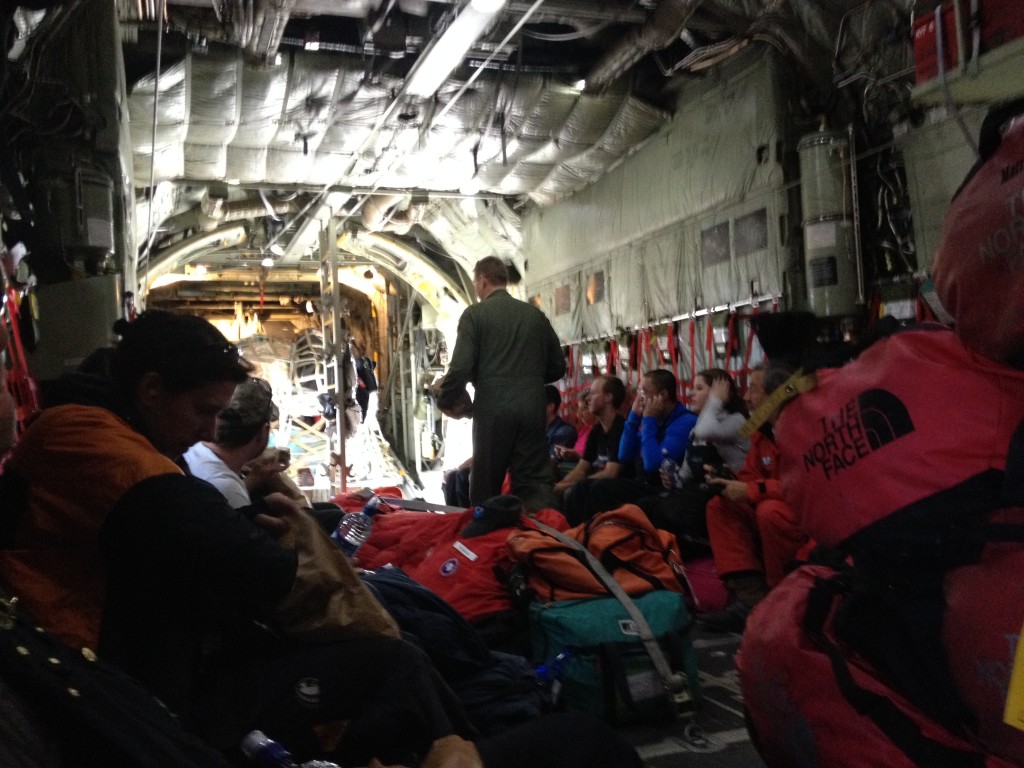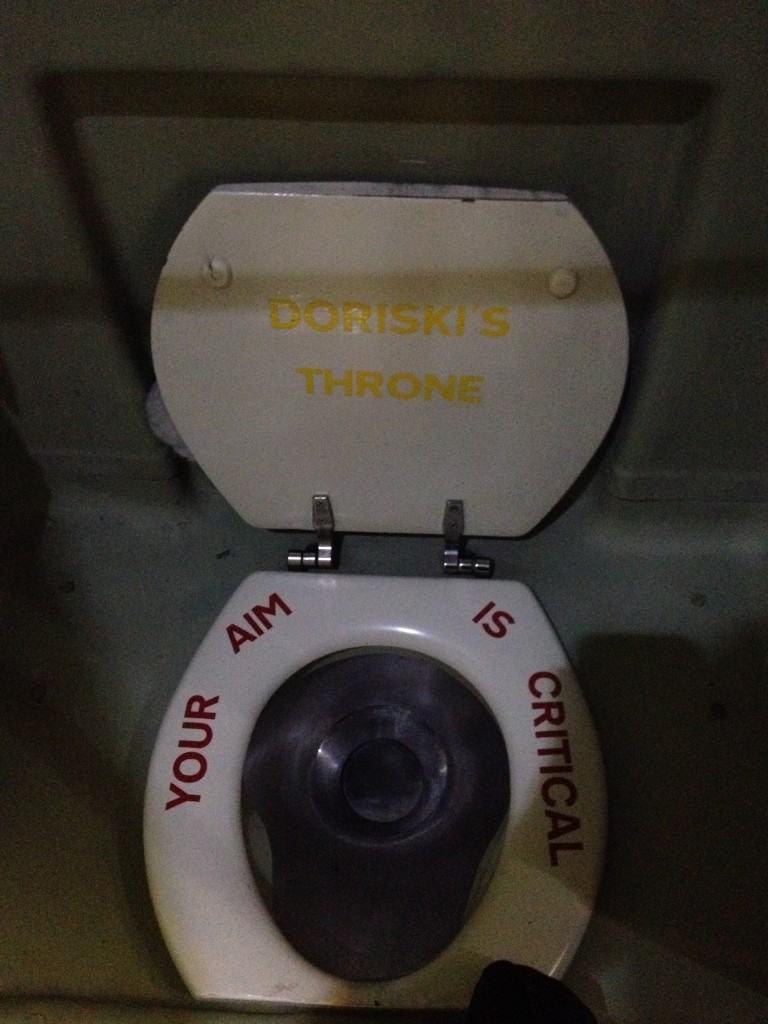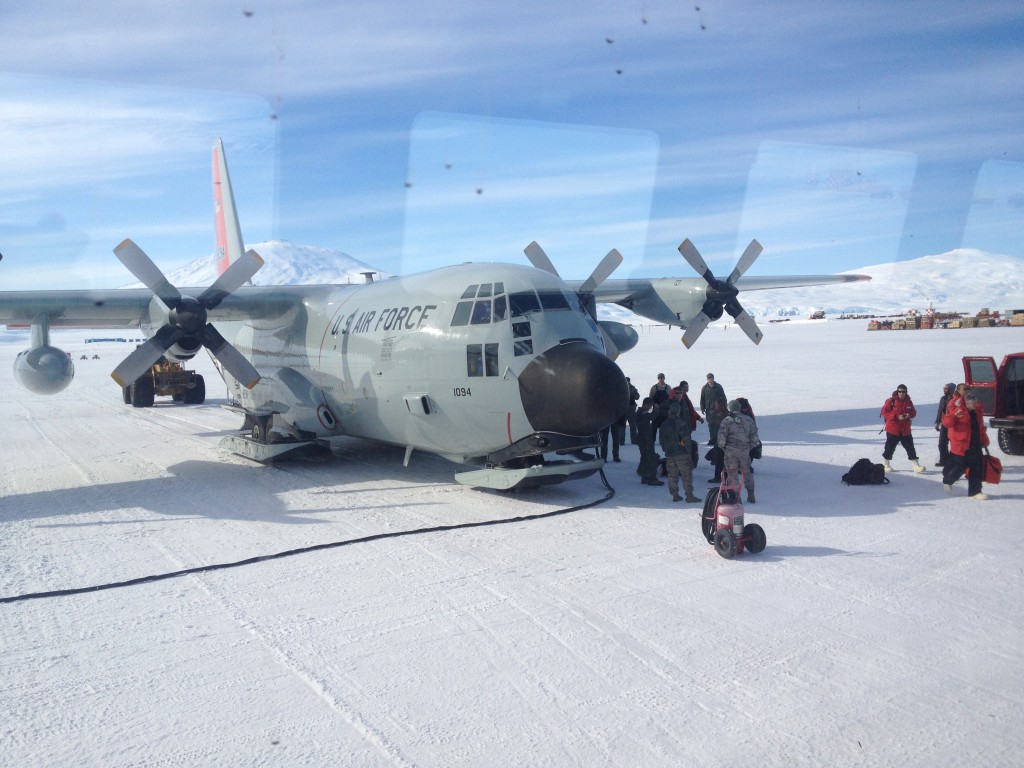I have been at McMurdo Station now for 30 hours and it has been a whirlwind.
I left my hotel in Christchurch lugging my bags, which then weighed closer to 100 pounds thanks to my Extreme Cold Weather gear.
Once at the clothing distribution center, I changed into the cold weather pants and packed everything according to the Antarctica system. You can have checked baggage that cannot exceed 85 pounds, including a boomerang bag.
Because weather at McMurdo is so changeable, it is not unusual for a flight to have to turn back to Christchurch before it lands in Antarctica. In that case, passengers can retrieve their boomerang bags, but not they’re checked luggage. So, it is recommended that passengers put a change of clothes and medications, etc in a boomerang bag, just in case.
After your checked luggage is packed, you are allowed a carry-on that has not weight restriction, but MUST fit into the prescribed space allotment. (I ended up putting most of my books in my carry-on, the skinny, heavy things.)
Next comes security. The U.S. Navy runs the flights and flight security out of Christchurch for ice- bound planes. After I had everything organized, I walked my stuff over to the passenger terminal and had my identity verified. Pretty typical plane stuff.
Next they weighed my checked luggage and my carry-on and me.
Instead of a ticket, I was issued a playing-card-sized ID tag that identified me as Passenger #26.
After that, I could leave the terminal (and my carry-on) to take advantage of the last breaths of 50- degree weather I would experience for a while.
At the prescribed time, all the passengers met back at the terminal for a(nother) safety and information video. This one served as general Antarctica information and the other was the safety information for the C-130 we were about to get on.
Next, we went through security ourselves and then boarded a bus that would take us across the street to the airport to the U.S. Antarctica Program planes.
The C-130 was dark, and looked like, I imagine, most planes without interior walls. Many pipes ran along the ceiling and walls for ventilation, electricity and various fluid movement.
Our carry-ons were “stowed” on hangings racks. Our emergency ventilation systems were bubbles you pull over your head with individual oxygen cylinders that sit at the nape of your neck. Our life vests were like the ones I’ve seen on every plane.
Our seats were canvas benches than ran the length of the cabin along the walls. The seat backs were sewn webbing. It wasn’t as uncomfortable as it sounds.
At the back of the plane, all the cargo was stacked on pallets. The bathrooms were just toilets in the wall. Once the plane is above 10,000 feet and people are allowed to walk around, the load masters (or military flight attendants) pull curtains around the toilets for privacy.
Andy and I sat by two small windows, but they were directly behind us, so we had to twist to see anything.
The plane was super loud! They gave us earplugs before boarding. I wore mine for the entire length of the flight from engine on to engine off.
While flying, we were free to eat the bagged lunches given us, get up and walk around, a try to talk. It was so loud, communication became Charades.
I spent most of my time reading and trying to find a comfortable way to sit. The plane ride lasted almost 8 hours, which is longer than most flights to McMurdo. The US Antarctic Program also uses C-17s and Airbus A380s. They only take about 5 hours. But we were on the slow bus.
The views, once we got south of the open water, were really pretty. It reminded me of flying over Alaska. We landed at Willy Field around 5:30 p.m. New Zealand time (McMurdo recognizes New Zealand time in summer and Denver time in winter). The landing was smooth.
Once off the plane, we were immediately put into a school bus that is jacked up on tractor-sized wheels. It’s called Ivan the Terra Bus. Not sure why.
Our driver was a 30-something lady with a pretty smile. The drive to the base took about 45 minutes. The planes land out on multi-year sea ice. As we drive back to shore, we got a nice view of Mt. Erebus (which we’re not allowed to climb).
Once on Ross Island proper, the road went past Scott Base, which is the New Zealand station on Ross Island. It’s much smaller than McMurdo, with only 100 people in summer and about 20 in winter.
I kept my eyes open for Richard once we were at McMurdo, but we were immediately shuffled into ANOTHER briefing. We met the station manager and some of his staff. We also got our room keys and met our direct supervisors. A nice, hipster lady named Kate is my boss. I like her glasses frames.
Richard showed up in the middle of my briefing. It was so nice to see him.
And in perfect Richard-fashion, as soon as my obligations were finished at the briefing, he immediately hurried me away to ANOTHERRRRR meeting. This one was mandatory to participate in any outdoor recreational activities at the base, so it was SUPER VITAL for me to get it done IMMEDIATELY. OR ELSE. Blerg.
I sat through the meeting, tired and hungry and wanting to be in a quiet room where we could actually talk instead of being talked to. Typical Richard.
Fortunately, the meeting didn’t last long and I made Richard take me to our room.
He only deviated slightly and I only had to yell at him once for taking me the “long” way.
My checked luggage wasn’t going to be available for another half-hour or so, so he gave me the orientation of our room.
We have two twin beds shoved together at the back of the room. A big, metal dresser, bed side table, mini fridge, desk, Richard’s bike and trainer, larger chair and shoe shelf that Richard made out of cardboard boxes.
Next, Richard gave me a tour of the base on the way to grabbing my bags.
Our room is in the same building as the galley (where I work) and just across the dirt from the medical building, where Richard works.
I unpacked and we ate food that Richard had snagged earlier.
Then I fell asleep until my body’s reaction to the dry air woke me. I am constantly itchy and thirsty. Hopefully I will adjust soon.


